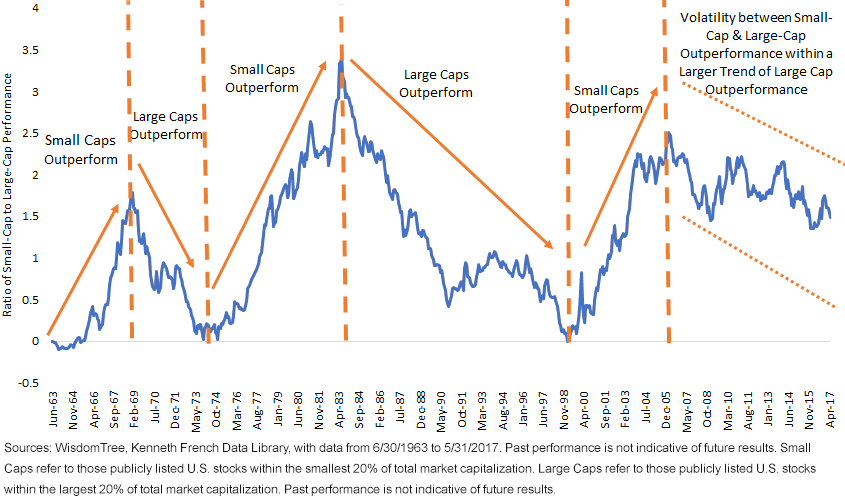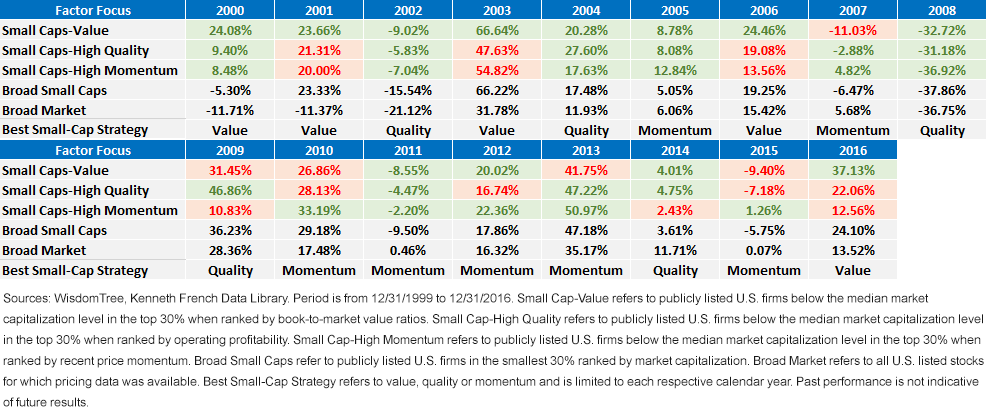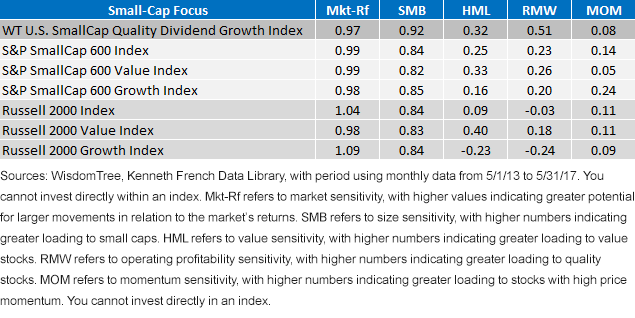Multiple Factors for Different Markets


Despite all of the noise reverberating within investment discussions today, the bottom line is that strong risk-adjusted performance drives people toward investment goals. Thinking about factors is one way to accomplish this objective.
Small Caps: A Classic Factor
If there is one factor that has become so ubiquitous that many people don’t even think of it in the factor context, it is size. Investors may not think of it in this context, but the amount of assets that follow indexes like the Russell 2000, S&P SmallCap 600 and CRSP U.S. Small Cap Indexes tell us that following the returns of U.S. small-cap stocks is popular.
Unfortunately, broad small caps don’t always outperform large caps—many of the studies that show their popularity and the pervasive intuition that “small outperforms large” are based on very long periods.
Cycles of Small-Cap and Large-Cap Outperformance in U.S. Equities

The swings between large-cap and small-cap equity performance during some of these cycles have been truly staggering:
- From December 1974 to July 1983, small caps delivered 36% per year while large caps delivered 14.7% per year.
- From July 1983 to March 1999—almost a full 16 years—large caps delivered 18.2% per year while small caps delivered 7.5% per year.
The period from 2006 onward has tended toward a greater degree of volatility. The longer-run cyclical trend appears to be large caps outperforming small caps, but within that trend there have been periods in which small caps have delivered strongly relative to large caps—just not strongly enough to break the bigger trend.
Increasing Your Odds within Small Caps—Using the Factors
Sophisticated investors utilize the factors to attempt to improve their chances of generating better risk-adjusted returns within a particular asset class. For multidecade periods, history has tended to show a strong potential for outperformance coming from a factor focus. However, in any given calendar year (or shorter) period, it can become very, very difficult to know which factor to tilt toward.
Small-Cap Factors: A Calendar Year Study from 2000 to 2016

- 2014, 2015 and 2016 demonstrate an important point. It would have been very difficult to—ahead of time—call out quality, momentum and then value as the top small-cap factor strategies. This was made even more challenging because one would have just seen momentum outperform for four calendar years in a row (2010–2013).
- For these 17 years, momentum was the top strategy for seven years, and value and quality each delivered as the top strategy in five years.
We believe that different factors will continue to shift in and out of favor across time.
Enter Multifactor Strategies to Deliver a More-Versatile Approach
For those not confident in their ability to switch between factors, multifactor approaches can deliver a much greater degree of potential versatility. It’s important to note that, even if an index doesn’t have the word “multifactor” in its name, it’s absolutely possible that it still taps into multiple factors. In fact, it’s fairly difficult for a strategy to solely touch a single factor and not be influenced by any others.
WisdomTree U.S. SmallCap Quality Dividend Growth Index: Size & Quality with Value & a Touch of Momentum

- We started this discussion with size, and the WisdomTree U.S. SmallCap Quality Dividend Growth Index tapped into this factor very strongly. With its focus on three-year average return on equity (ROE) and return on assets (ROA), it also delivered nearly twice the loading-to-operating profitability as the next highest loaded index to this factor. Notably, the growth indexes shown here do not offer all that great of a proxy for quality.
- Value in this context references “high book-to-market value minus low book-to-market value.” Since this is predominantly how the S&P SmallCap 600 Value Index and the Russell 2000 Value Index define value, they load well to this factor. The WisdomTree strategy doesn’t focus on book-to-market value at all, but it still loads fairly strongly to this factor.
- Over this particular period, all of the small-cap indexes we show did have a positive loading toward momentum. The S&P SmallCap 600 Growth Index was most strongly loaded to this factor. WisdomTree’s rebalance, focused on relative valuation, may not tend toward the best capture of exposure to momentum, but the quality and growth focus employed by the WisdomTree U.S. SmallCap Quality Dividend Growth Index coincided with some momentum tilts over this period.
When Do You Say “No” to Quality and Dividend Growth?
Quality and dividend growth are two concepts that resonate strongly with investors. Many investors who like to select individual stocks do so with these attributes affecting their selection criteria. What we think most investors may not realize is that you don’t need to focus solely on large-cap stocks to achieve this objective.
Important Risks Related to this Article
Investments focusing on certain sectors and/or smaller companies increase their vulnerability to any single economic or regulatory development.

Christopher Gannatti began at WisdomTree as a Research Analyst in December 2010, working directly with Jeremy Schwartz, CFA®, Director of Research. In January of 2014, he was promoted to Associate Director of Research where he was responsible to lead different groups of analysts and strategists within the broader Research team at WisdomTree. In February of 2018, Christopher was promoted to Head of Research, Europe, where he was based out of WisdomTree’s London office and was responsible for the full WisdomTree research effort within the European market, as well as supporting the UCITs platform globally. In November 2021, Christopher was promoted to Global Head of Research, now responsible for numerous communications on investment strategy globally, particularly in the thematic equity space. Christopher came to WisdomTree from Lord Abbett, where he worked for four and a half years as a Regional Consultant. He received his MBA in Quantitative Finance, Accounting, and Economics from NYU’s Stern School of Business in 2010, and he received his bachelor’s degree from Colgate University in Economics in 2006. Christopher is a holder of the Chartered Financial Analyst Designation.

